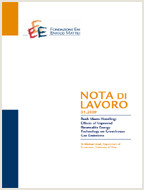Temperature Anomalies, Radiative Forcing and ENSO

14.02.2017
C32
Temperature Anomaly, Global Warming, Warming Hiatus, Radiative Forcing, ENSO, El Niño, Conditional Heteroskedasticity, Semiparametric Dynamic Conditional Correlation Model
Economic Theory and Applications
Carlo Carraro
The paper investigates the linkages between temperature anomalies, radiative forcing and ENSO. By means of a new flexible trend modeling approach, we uncover a nonlinear linkage between radiative forcing and global temperature anomalies. The nonlinear trend closely tracks the low frequency evolution in temperature anomalies, also accounting for the mid-end 1990s level switch, the 1998-2013 “warming hiatus” and the current steepening in trend temperatures. Radiative forcing is also found to account for trend dynamics in the Southern Oscillation Index (SOI), therefore providing support for the view that global warming might affect natural variability oscillations such as ENSO, and therefore enhance their disruptive effects. We also document the feature of time-varying volatility of temperature anomalies and SOI, which is well described by an IGARCH process. By means of a new dynamic conditional correlation model (SP-DCC), we finally document the presence of time-varying conditional correlations relating temperature anomalies across various zones and SOI. The correlation pattern is found to be consistent with the effects of ENSO events in the Tropics and their teleconnections.
***
Suggested citation: Morana, C., G. Sbrana, (2017), ‘Temperature Anomalies, Radiative Forcing and ENSO’, Nota di Lavoro 9.2017, Milan, Italy: Fondazione Eni Enrico Mattei
